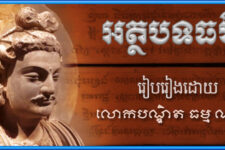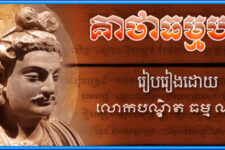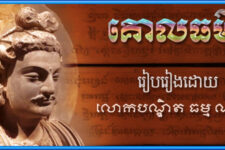ព្រះត្រៃបិដក៖ គម្ពីរដែលពុទ្ធសាសនិកត្រូវតែដឹង(១)
លំនាំសេចក្ដី
ព្រះពុទ្ធសាសនាមិនមែនទស្សនវិជ្ជា
មុននឹងនិយាយអំពីព្រះត្រៃបិដក យើងចាំបាច់ត្រូវញែកឱ្យច្បាស់រវាងទស្សនវិជ្ជានិងសាសនា ។ ទស្សនវិជ្ជាជារឿងគិតរកហេតុផលជាចំបង ដើម្បីឈានទៅរកខសន្និដ្ឋានការពិត ដោយឆ្លងកាត់ការជជែកគ្នាក្នុងហេតុផលនោះៗ រឿងដែលជជែកគ្នាឬគិតនោះ អាចមិនទាក់ទងដល់ដំណើរជីវិតដែលកំពុងប្រព្រឹត្តទៅ ឧទាហរណ៍ ពួកទស្សនវិទូអាចជជែកគ្នាថា ចក្រវាឡកើតឡើងពីពេលណានិងដល់ទីបំផុតពេលណា លោកនេះនឹងសាបសូន្យពេលណា ជីវិតបានកកើតឡើងពេលណា ជាដើម ហើយពួកទស្សនវិទូក៏មិនចាំបាច់ត្រូវមានដំណើរជីវិតតាមគោលការណ៍អ្វីៗ ឬសូម្បីតែបត្រិបត្តិខ្លួនឱ្យសមស្របតាមអ្វីដែលខ្លួនគេគិតក៏មិនចាំបាច់ដែរ ។ ក្នុងខណៈដែលការគិតស្វែងរកហេតុផលនៃការពិតកំពុងប្រព្រឹត្តទៅ ជីវិតផ្ទាល់ខ្លួនរបស់ពួកគេអាចផ្ទុយស្រឡះអំពីរឿងដែលពួកគេកំពុងគិតក៏មាន ឧទាហរណ៍ ពួកទស្សនវិទូខ្លះអាចមានជីវិតស្ទើរឆ្កួតស្ទើរជា ស្រវឹងខួប ញៀនល្បែង ខ្លះក៏ជាទុគ៌តជនមានសម្ពាធជីវិតរហូតដល់ធ្វើអត្តឃាតជាដើម ។
ផ្ទុយទៅវិញ សាសនាជារឿង“ការប្រតិបត្តិ” ជាវិធីសម្រាប់ដំណើរជីវិត ឬជាការនាំមកអនុវត្តឱ្យកើតជាប្រយោជន៍សម្រាប់ជីវិតពិតៗ ។ វិធីប្រតិបត្តិរបស់សាសនាត្រូវមានគោលការណ៍ច្បាស់លាស់ ឬក៏គោលការណ៍មូលដ្ឋានដែលជាទីទទួលយកថាជារឿងពិត ប្រកបដោយគោលដៅដែលបានបញ្ជាក់ទុកយ៉ាងច្បាស់លាស់ ។
ព្រោះហេតុនេះហើយ ជាកិច្ចចាប់ផ្ដើម អ្នកបដិបត្តិគឺសាសនិកត្រូវទទួលបដិបត្តិតាមគោលការណ៍របស់សាសនានោះៗ តាមដែលអង្គព្រះសាស្ដាបានសម្ដែងទុក ដែលហៅថា ពាក្យប្រៀនប្រដៅ ។ ដោយហេតុនេះហើយ សាសនិកត្រូវយកចិត្តទុកដាក់ចំពោះពាក្យប្រៀនប្រដៅរបស់ព្រះសាស្ដា ដែលត្រូវបានប្រមូលរួបរួមនិងរក្សាទុកបន្ដគ្នាជាលំដាប់តរៀងមក ក្នុងលក្ខណៈជាគម្ពីរក្បួនខ្នាត ។
មើលពីទស្សនវិស័យពីជ្រុងជ្រោយនេះ ព្រះពុទ្ធសាសនាមិនមែនជាទស្សនវិជ្ជា តែជាសាសនា មានព្រះសមណគោតមជាព្រះបរមសាស្ដា ដែលពុទ្ធសាសនិកជឿមាំក្នុងការត្រាស់ដឹងរបស់ព្រះអង្គ ។ ព្រះពុទ្ធសាសនាបង្រៀនអំពីមាគ៌ាសម្រាប់ជីវិតដែលទីបំផុតនឹងឱ្យបានដល់គោលដៅគឺសេចក្ដីផុតទុក្ខ ។ គម្ពីរខ្នាតធំដែលជាទីរក្សាគោលការណ៍នៃពាក្យប្រៀនប្រដៅរបស់ព្រះពុទ្ធទុកហៅថា ព្រះត្រៃបិដក ពុទ្ធសាសនិកពិតត្រូវបដិបត្តិតាមគោលការណ៍យ៉ាងត្រឹមត្រូវ ដើម្បីនឹងទទួលនូវប្រយោជន៍អំពីសាសនាឱ្យបានច្រើនបំផុត ហើយដើម្បីជាការធានារ៉ាប់រងវិធីបដិបត្តិដ៏ត្រឹមត្រូវ ជាការចាំបាច់ដែលត្រូវយល់អំពីព្រះត្រៃបិដកជាមូលដ្ឋានសិន ។
——————————————-
សេចក្ដីប្រែជាខេមរភាសា គ្រាន់តែជាជំនួយសម្រាប់អ្នកដែលអានអង់គ្លេសមិនបានប៉ុណ្ណោះ
សម្រាប់អ្នកចេះភាសាអង់គ្លេស សូមអញ្ជើញអានខាងក្រោម ។
ដកស្រង់ពីៈ The Pali Canon: What a Buddhist Must Know.
By Ven. Bhikkhu P.A. Payutto
ប្រែសម្រួលអត្ថបទដោយ តាអារាមប៊យ
៧ តុលា ២០១៩
————————————
THE PALI CANON: What a Buddhist must know(1)
Introduction
Buddhism is not a philosophy
Before going on to talk about the Pāli Canon, it is necessary to make a distinction between philosophy and religion. Philosophy is primarily concerned with rational speculation, to try to arrive at the truth of something through reasoning or argumentation. What is at issue or being investigated might not have anything to do with how one’s life is actually conducted. For instance, philosophers might debate the question of the origin and the end of the universe, the doomsday, or the origin of life. Furthermore, the ways philosophers lead their lives do not necessarily follow any principle, or even conform to what they investigate. While they are doing their philosophical thinking, their personal lives might be just the opposite. Some philosophers, for example, could be highly volatile and unpredictable, some could be habitually up to no good, indulging in drinking or gambling, and some were so miserable and depressed that they committed suicide.
By contrast, religion involves practice, a way of living, or useful application in real life. The way a religion is practiced has to be based on a definitive canon, or fundamental principle accepted as axiomatic, with a clearly stated goal.
Thus, practitioners of a given religion will at the outset have to abide by the tenets of that religion as laid down by its founder, which are referred to as his teachings. For this reason, a religious practitioner will direct his attention to the founder’s teachings, which are collected, preserved, and handed down in the form of a scripture.
Viewed from this perspective, Buddhism is not a philosophy, but a religion. With Gotama the Buddha being the founder, whose Enlightenment all Buddhists believe in, Buddhism teaches a way of life which ultimately leads to the goal of final deliverance from suffering. The voluminous scripture where the tenets of Buddhism can be found is called Pāli Canon. To derive the most benefit from the religion, a true Buddhist has to practice it properly. And to ensure the right practice, a basic understanding of the Pāli Canon is called for.
Phra Brahmagunabhorn (P. A. Payutto)
Translated from Thai by Dr. Somseen Chanawangsa.



